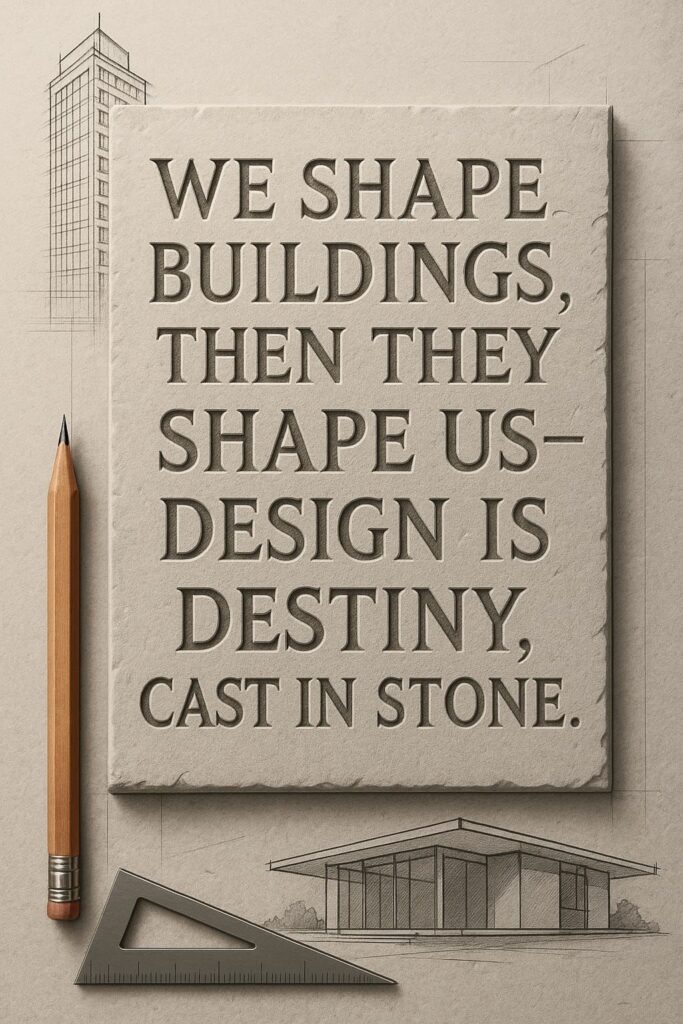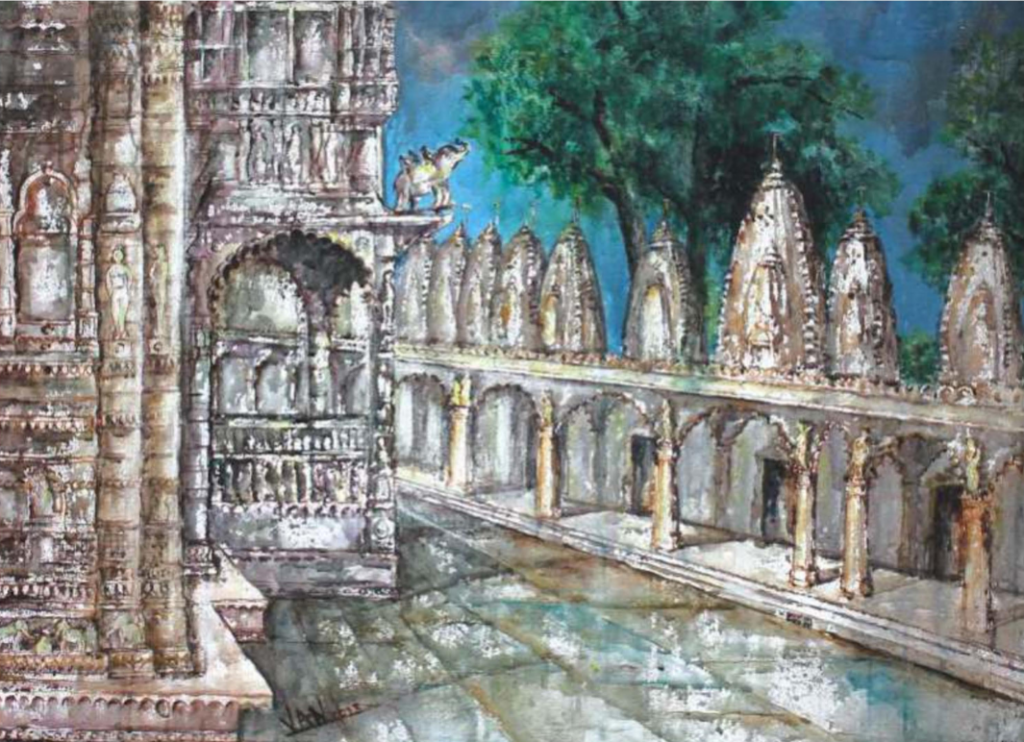~Winston Churchill Winston Churchill's profound statement, "We shape our buildings, and afterwards our buildings shape us," is a cornerstone of architectural philosophy.1 The slightly embellished version, "Design is Destiny, Cast in Stone," powerfully augments his original insight, transforming it from a mere observation into a declaration of immense responsibility and enduring impact. For an architect, …

~Winston Churchill
Table of Contents
- The Architect’s Agency: “We Shape Buildings”
- Vision and Intentionality
- Function, Form, and Context
- The Built Environment’s Influence: “Then They Shape Us”
- Impact on Individual Behavior and Well-being
- Influence on Culture and Society
- The Enduring Reality: “Design is Destiny, Cast in Stone”
- The Immutability of Stone (and Steel, and Concrete)
- Legacy and Future Generations
- The Weight of Responsibility
- The Architect’s Mandate: Shaping Destiny with Foresight and Empathy
- Beyond Aesthetics and Function
- The Need for Foresight and Adaptability
- Empathy as a Design Tool
- Collaboration as a Catalyst
- Conclusion: The Perpetual Cycle of Influence
Winston Churchill’s profound statement, “We shape our buildings, and afterwards our buildings shape us,” is a cornerstone of architectural philosophy.1 The slightly embellished version, “Design is Destiny, Cast in Stone,” powerfully augments his original insight, transforming it from a mere observation into a declaration of immense responsibility and enduring impact. For an architect, this quote is not just a clever turn of phrase; it is the very essence of our profession, a constant reminder of the profound, reciprocal relationship between humanity and the built environment. It underscores the indelible mark our creations leave, not merely on the landscape, but on the lives, behaviors, cultures, and destinies of those who inhabit them.2
The Architect’s Agency: “We Shape Buildings”
The first half of the quote, “We shape buildings,” articulates the architect’s primary role as a creator. This is the realm of agency, intention, and the transformation of abstract ideas into concrete forms. It is where vision, function, aesthetics, and technical prowess converge.
Vision and Intentionality
Before any material is laid, a building exists as a concept, a response to a need, a vision in the mind of the architect. “We shape buildings” implies a deliberate act of will and intellect. An architect doesn’t merely assemble components; they imbue space with purpose, character, and meaning.3 Every line drawn on a plan, every material chosen, every decision about light, shadow, and proportion is an intentional act designed to elicit a specific experience or facilitate a particular activity.
Consider the design of a hospital: the architect shapes it with an intent to heal, to provide comfort, and to optimize the efficiency of medical care. A school is shaped to foster learning, collaboration, and a sense of community. A home is shaped to offer shelter, security, and a reflection of its inhabitants’ lives. This shaping goes beyond mere aesthetics; it delves into the psychology of space, the flow of human movement, and the subtle cues that guide interaction and emotion.4 The architect becomes a sculptor of human experience, carefully orchestrating how people will move, feel, and interact within the proposed environment.5
Function, Form, and Context
The shaping process is a complex interplay of various forces.
- Function: Buildings must serve a purpose. An architect shapes spaces to accommodate specific activities, workflows, and human needs.6 This involves rigorous programming, understanding adjacencies, and optimizing circulation.
- Form: The aesthetic expression of a building, its geometry, massing, and external appearance, are crucial.7 Form is not arbitrary; it emerges from function, context, and the architect’s artistic vision, aiming to create beauty, order, or even a deliberate challenge to convention.
- Context: No building exists in a vacuum. It is shaped by its site – its topography, climate, existing urban fabric, and historical layers. A truly responsible architect shapes buildings to respond to and enrich their surroundings, rather than imposing a foreign object upon them. This might involve respecting vernacular traditions, integrating with natural landscapes, or sensitively negotiating the scale and character of adjacent structures.
- Materials and Technology: The choice of materials profoundly influences a building’s character, performance, and environmental impact.8 Architects shape buildings by selecting and detailing materials that resonate with the design intent, contribute to sustainability, and age gracefully.9 Likewise, embracing new technologies – from structural systems to smart building controls – allows architects to push the boundaries of what is possible, enabling more efficient, responsive, and innovative forms of shaping.10
This “shaping” phase is a period of intense creativity, problem-solving, and collaboration. It involves endless sketches, models, drawings, and discussions, where ideas are tested, refined, and eventually distilled into a coherent blueprint for construction. It is an act of proactive creation, where the architect wields considerable power to define the future built environment.
The Built Environment’s Influence: “Then They Shape Us”
The second part of Churchill’s quote, “then they shape us,” illuminates the profound, often subconscious, influence of the built environment on human behavior, psychology, and societal structures.11 Once a building is constructed, it ceases to be merely a creation; it becomes an active agent, subtly but powerfully dictating how we live, work, interact, and even think.12
Impact on Individual Behavior and Well-being
Architecture is not a neutral backdrop; it actively molds our daily lives.13
- Psychology and Mood: A building’s design can evoke specific emotional responses. A space bathed in natural light, with expansive views and natural materials, often promotes feelings of calm, well-being, and productivity.14 Conversely, dim, cramped, or poorly ventilated spaces can lead to stress, fatigue, and even exacerbate mental health issues.15 Hospitals designed with patient comfort, natural light, and access to nature have demonstrably better patient outcomes.
- Social Interaction: The layout of a public square can encourage impromptu gatherings or isolate individuals.16 The arrangement of desks in an office can foster collaboration or promote solitary work.17 Wide, inviting staircases might encourage physical activity over elevators.18 Buildings can facilitate or hinder human connection through their spatial organization, choice of common areas, and thresholds between private and public zones.19
- Productivity and Focus: In workspaces, factors like acoustics, air quality, lighting, and layout directly influence concentration, creativity, and efficiency.20 An architect’s decision on an open-plan office versus private cubicles has a direct impact on communication patterns and individual work styles.21
- Movement and Navigation: The way buildings are planned dictates human movement. Clear sightlines, intuitive wayfinding, and logical circulation paths reduce stress and enhance usability.22 Conversely, confusing layouts can lead to frustration and disengagement. Think of the psychological impact of being lost in a large, un-designed space versus effortlessly navigating a well-planned one.
Influence on Culture and Society
Beyond the individual, buildings exert a powerful shaping force on communities and culture.23
- Community Identity: Landmark buildings, public squares, and distinctive urban forms contribute to a city’s identity and memory.24 They become symbols of collective aspiration, historical events, or cultural values.25 The Parliament building Churchill spoke of, with its confrontational layout, was seen by him as embodying British democratic debate.
- Social Equity and Access: Design decisions can either promote inclusivity or perpetuate exclusion.26 Universally accessible design ensures that buildings can be used by everyone, regardless of physical ability.27 Conversely, poorly designed public spaces or gated communities can reinforce social divides.28
- Environmental Consciousness: Buildings with sustainable design features—such as passive solar heating, natural ventilation, and green roofs—not only reduce environmental impact but also subtly educate their inhabitants about ecological principles, fostering a more sustainable lifestyle. The presence of biophilic elements like indoor plants or views of nature can shape our appreciation for the natural world.
- Historical Memory: Buildings are tangible links to the past.29 They embody historical periods, architectural styles, and the values of their time.30 Their preservation or demolition shapes our collective memory and understanding of history, influencing how future generations perceive their heritage.31
The “shaping” exerted by buildings is often insidious, working on a subconscious level over time. We adapt to our environments, and these adaptations, repeated daily, slowly but surely mold our habits, expectations, and even our collective consciousness.32
The Enduring Reality: “Design is Destiny, Cast in Stone”
The addition, “Design is Destiny, Cast in Stone,” elevates Churchill’s observation to a more profound and sobering truth, particularly for the architect. It speaks to the permanence and long-term implications of architectural decisions.
The Immutability of Stone (and Steel, and Concrete)
Unlike a painting that can be moved or a song that can be reinterpreted, a building is largely immutable once constructed. It occupies a fixed point in space and time, often for decades or even centuries. While renovations and adaptive reuse are possible, the core structure and spatial organization, the “bones” of the building, are “cast in stone.” This permanence means that the design decisions made today will literally shape generations to come.
This inherent longevity imbues the architect’s role with immense responsibility. A well-designed building can be a source of inspiration, comfort, and functionality for a very long time. Conversely, a poorly designed or ill-conceived structure can become a burden – inefficient, uncomfortable, unsustainable, or even detrimental to its inhabitants and the urban fabric.33 It can become a “destiny” of discomfort or dysfunction, difficult and costly to alter.
Legacy and Future Generations
For the architect, “Design is Destiny” is a powerful reminder of legacy. Every project is a contribution to the built heritage that will influence not just immediate users but also future generations. What message do our buildings convey to those who will inherit them? Do they speak of foresight and care, or of expediency and short-sightedness?
This aspect of destiny forces architects to consider not just the immediate client brief but also the long-term societal and environmental consequences of their work.34 It necessitates a deep understanding of urban planning, sustainability, and adaptability, ensuring that today’s designs do not become tomorrow’s liabilities. Designing for longevity and flexibility becomes crucial, allowing buildings to adapt to future, unforeseen needs rather than becoming rigid, deterministic structures.35
The Weight of Responsibility
The phrase “cast in stone” highlights the irreversibility of many architectural decisions. While other creative disciplines have opportunities for rapid iteration and correction, a building, once erected, stands as a testament to its design choices. This places a significant ethical burden on architects to ensure their designs are not only aesthetically pleasing and functional but also socially equitable, environmentally responsible, and resilient.36 The “destiny” imparted by design can be one of empowerment and delight, or conversely, one of constraint and deprivation.
Consider the “destiny” of communities shaped by urban renewal projects of the mid-20th century, which often prioritized automobile traffic over human-scaled environments, or tore down vibrant neighborhoods in favor of isolated towers. These decisions, “cast in stone,” led to decades of social alienation and environmental degradation, demonstrating the negative “destiny” that can result from design without comprehensive foresight or empathy.
The Architect’s Mandate: Shaping Destiny with Foresight and Empathy
Churchill’s quote, amplified by the idea of “Design is Destiny, Cast in Stone,” serves as the ultimate ethical and practical mandate for the architect. It is a call to conscious, responsible design.
Beyond Aesthetics and Function
While aesthetics and function remain paramount, the architect’s role extends far beyond these traditional parameters.37 We are, in essence, social engineers, environmental stewards, and cultural custodians. Every design decision carries with it an implicit prophecy about the future – how people will live, how resources will be consumed, how communities will interact.
The Need for Foresight and Adaptability
Understanding that “Design is Destiny” compels architects to cultivate foresight. We must design not just for today’s needs but also for potential future uses, technological advancements, and environmental changes.38 This means incorporating flexibility, modularity, and resilience into our designs, allowing buildings to evolve rather than become obsolete. It also requires a deep engagement with building performance simulations, material science, and urban data to make informed decisions that ensure positive long-term outcomes.
Empathy as a Design Tool
To truly shape buildings that positively shape us, architects must practice radical empathy. This involves understanding the diverse needs, aspirations, and behaviors of the people who will inhabit their creations – from different age groups and cultural backgrounds to varying physical abilities and socio-economic statuses. It means listening carefully, observing keenly, and designing with genuine consideration for the human condition in all its complexity. An empathetic design understands that a building is not an object to be admired but a stage for human life.
Collaboration as a Catalyst
Given the multi-faceted nature of design’s impact, collaboration is no longer a luxury but a necessity. Architects must engage with clients, engineers, urban planners, policymakers, and critically, the future users of their spaces.39 This iterative, inclusive process helps uncover potential “destinies” and allows for the shaping of buildings that are more responsive, resilient, and beneficial.
Conclusion: The Perpetual Cycle of Influence
Churchill’s powerful statement, especially with the added resonance of “Design is Destiny, Cast in Stone,” profoundly defines the architect’s profound responsibility. We are not merely creators of shelter or form; we are definers of experience, facilitators of interaction, and silent shapers of human destiny. Every brick laid, every beam raised, every space articulated in our designs contributes to a future that is, in part, predetermined by our choices.
The cycle is perpetual: humanity shapes the built environment, and that environment, in turn, shapes humanity.40 This reciprocal influence is the very essence of architectural power. For the architect, this quote is a constant call to action – a reminder that our work is not just about building structures, but about constructing futures. It is a profound privilege and an immense challenge to craft the “stone” that will define destinies, making the conscious and responsible act of design the most critical endeavor for shaping a better world.






